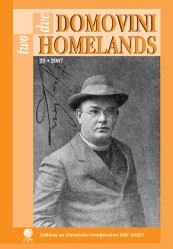Some Demographic Characteristics of the Greek-Catholic Žumberčani Population in Slovenia
Keywords:
Ethnicity, descendents of Uskoks, Greek-Catholics, Slovene-Croatian border regions, region of Bela krajinaAbstract
The essay discusses Žumberčani population in Slovenia. They immigrated to Slovenia from the hilly region of Žumberk, app. 15 to 40 km west of the Croatian Capital Zagreb along the Slovenian-Croatian state border. Mostly they are descendents of the Uskoki, the population that had immigrated from the Balkans after the Ottoman conquest of the region. In the 1611, the majority of the Uskoks from Žumberak became Greek-Catholics, Eastern Christians, which are directly subject to the Pope in Rome. Žumberk was a part of Military Border Region, which was organized as defense belt against the Ottomans by Habsburgs; Žumberčani were recruited professional soldiers by the Hapsburg Empire. After the abolishment of the Military Border Region in 1881, the life and economic conditions in Žumberk changed dramatically. Since then, Žumberk demographically has become an exodus zone. Žumberčani were forced to migrate to other regions of Habsburg Empire and to other states, predominantly to the USA, France and Germany. Since 1880, Žumberčani have migrated in larger numbers towards the border regions along the present Slovenian-Croatian state border, especially to Bela krajina, Novo mesto and Posavje in Southeastern Slovenia, and to larger cities, such as Ljubljana. This is also the geographical framework of our analyses of the present Žumberčani population in Slovenia. More than half out of 671 Žumberčani, and 772 other persons living with them in the same households (families), live in Municipality of Metlika in Bela krajina. Other persons are individuals that were not born in Žumberk settlements in Croatia neither did they declare themselves as Greek-Catholics in population census. Žumberčani are demographically older population then the majority in the region. They are more concentrated in urban settlements and have a larger proportion of males. The differences in employment end education structure of Žumberčani in comparison with entire population in the region are statistically not significant. The majority of the middle aged, and particularly the young generations of Žumberčani live in ethnically and religiously heterogeneous households and families. Yet the analyses show the important shift in younger population from declared Croats to Slovenians, and the Greek-Catholics to Roman-Catholics. Trends are less strong in Municipality of Metlika where Žumberčani represent a larger proportion in local population.
Downloads
References
Crkvenčić, Ivan. (2002). Žumberačka Gora – Transformation from a Refuge to an Exodus Zone. Migracijskei etničke teme, 18, 4, str. 289–306.
Hranilović, Nada (1990 a). Osnovna obilježja i analiza nekih strukturalnih promjena hrvatske žumberačke naseobine u Clevelandu. Migracijske teme 6, 2, str. 195–221.
Hranilović, Nada (1990 b). Žumberčani – subetnička grupa u Hrvata. Migracijske teme 6, 4, str. 593–612.
Josipovič, Damir (2006). Učinki priseljevanja v Slovenijo po drugi svetovni vojni. Ljubljana: Založba ZRC.
Komac, Miran, Romana Bešter, Mitja Hafner-Fink, Marina Lukšič Hacin, Felicita Medved, Mojca Medvešek, Mirjam Milharčič Hladnik, Petra Roter, Natalija Vrečer (2006). Percepcija slovenske integracijske politike. Ljubljana: Inštitut za narodnostna vprašanja.
Knežević Hočevar, Duška (2004). »Kri ni voda«: potomci Uskokov ob slovenskohrvaški meji. Razprave in gradivo 45, str. 126–143.
Narodnosni i vjerski sastav stanovništva Hrvatske 1880. – 1991. Zagreb: Državni zavod Republike Hrvatske za statistiku, 1998.
Popis prebivalstva, gospodinjstev, stanovanj in kmečkih gospodarstev v Republiki Sloveniji v letu 1991. Ljubljana: Zavod Republike Slovenije za statistiko.
Popis prebivalstva, gospodinjstev, stanovanj v Republiki Sloveniji v letu 2002. Ljubljana: Statistični urad Republike Slovenije.
Šircelj, Milivoja (2003). Verska, jezikovna in narodna sestava prebivalstva Slovenije. Ljubljana: SURS.
Šuklje, Marko (1937). Izseljevanje in doseljevanje v Žumberku. Geografski vestnik 12/13, str. 170–183.
Downloads
Published
How to Cite
Issue
Section
License

This work is licensed under a Creative Commons Attribution-NonCommercial-NoDerivatives 4.0 International License.
Authors guarantee that the work is their own original creation and does not infringe any statutory or common-law copyright or any proprietary right of any third party. In case of claims by third parties, authors commit their self to defend the interests of the publisher, and shall cover any potential costs.
More in: Submission chapter





